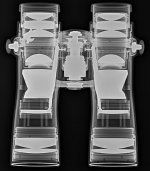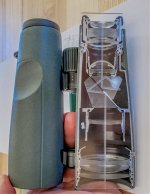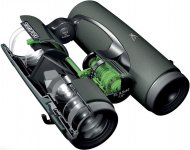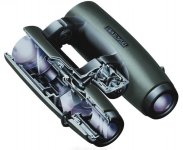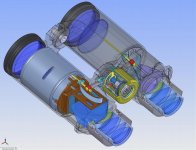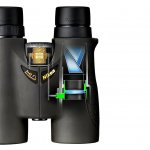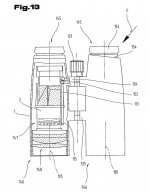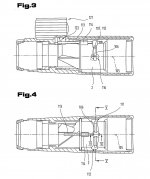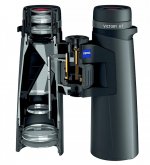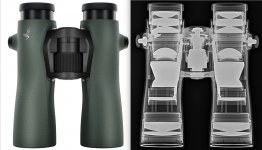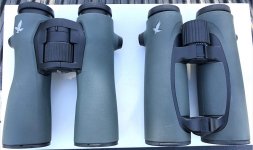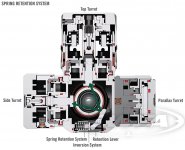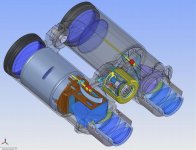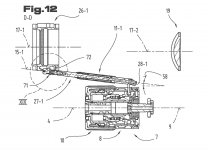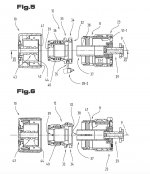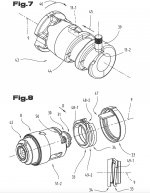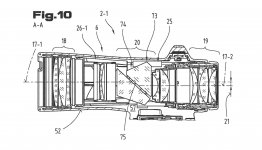John A Roberts
Well-known member

Arek at Allbinos has uploaded 2 x-rays showing the optical construction of the NL 8x42. The x-rays were provided by 3mnich and show both a front and rear view,
and can be found at: https://www.allbinos.com/282-news-Optical_construction_of_Swarovski_NL_Pure_binoculars.html
As can be seen, the pattern of the optical construction is the same as that of the EL Swarovision
i.e. both have the same number of lenses, in the same general configuration - though the lenses differ in detail (especially the field flattener lenses) *
There are 10 lenses in 7 groups:
- an objective of 4 lenses in 3 groups (1, 2 + 1 focusing)
- an eyepiece of 6 lenses in 4 groups (2, 1, 2, 1) with the first 2 lenses providing the field flattening function
The image shows how the Schmidt-Pechan prism pairs are rotated 90 degrees on their main optical axis to enable the reduced waist of the external body
The x-ray also shows the main detail of the focuser mechanism, in particular the use of angled rods to move the focuser lenses
The mechanism seems to incorporate some elements from the original EL (see the differing designs of the EL SV and the EL)
(and for more images of the construction of the EL and EL SV also see: https://www.birdforum.net/showthread.php?t=375673 )
John
* the NL specification sheet indicates that the it has 24 optical elements, so 12 per side, which means 10 lenses per side
go to Downloads at: https://aa.swarovskioptik.com/birding/nl-pure-c21011201/nl-pure-8x42-p5598795
Other image sources:
- Image #2 of the EL SV is from a 2018 visit to the Swarovski factory by Park Cameras at: https://blog.parkcameras.com/2018/05/exploring-swarovski-optiks-binoculars-spotting-scopes.html
- Image #5 of the EL is from the design software firm SolidWorks at: https://www.pressebox.de/pressemitt...ski-Optik-entstehen-in-SolidWorks/boxid/63252
and can be found at: https://www.allbinos.com/282-news-Optical_construction_of_Swarovski_NL_Pure_binoculars.html
As can be seen, the pattern of the optical construction is the same as that of the EL Swarovision
i.e. both have the same number of lenses, in the same general configuration - though the lenses differ in detail (especially the field flattener lenses) *
There are 10 lenses in 7 groups:
- an objective of 4 lenses in 3 groups (1, 2 + 1 focusing)
- an eyepiece of 6 lenses in 4 groups (2, 1, 2, 1) with the first 2 lenses providing the field flattening function
The image shows how the Schmidt-Pechan prism pairs are rotated 90 degrees on their main optical axis to enable the reduced waist of the external body
The x-ray also shows the main detail of the focuser mechanism, in particular the use of angled rods to move the focuser lenses
The mechanism seems to incorporate some elements from the original EL (see the differing designs of the EL SV and the EL)
(and for more images of the construction of the EL and EL SV also see: https://www.birdforum.net/showthread.php?t=375673 )
John
* the NL specification sheet indicates that the it has 24 optical elements, so 12 per side, which means 10 lenses per side
go to Downloads at: https://aa.swarovskioptik.com/birding/nl-pure-c21011201/nl-pure-8x42-p5598795
Other image sources:
- Image #2 of the EL SV is from a 2018 visit to the Swarovski factory by Park Cameras at: https://blog.parkcameras.com/2018/05/exploring-swarovski-optiks-binoculars-spotting-scopes.html
- Image #5 of the EL is from the design software firm SolidWorks at: https://www.pressebox.de/pressemitt...ski-Optik-entstehen-in-SolidWorks/boxid/63252
Attachments
Last edited:




